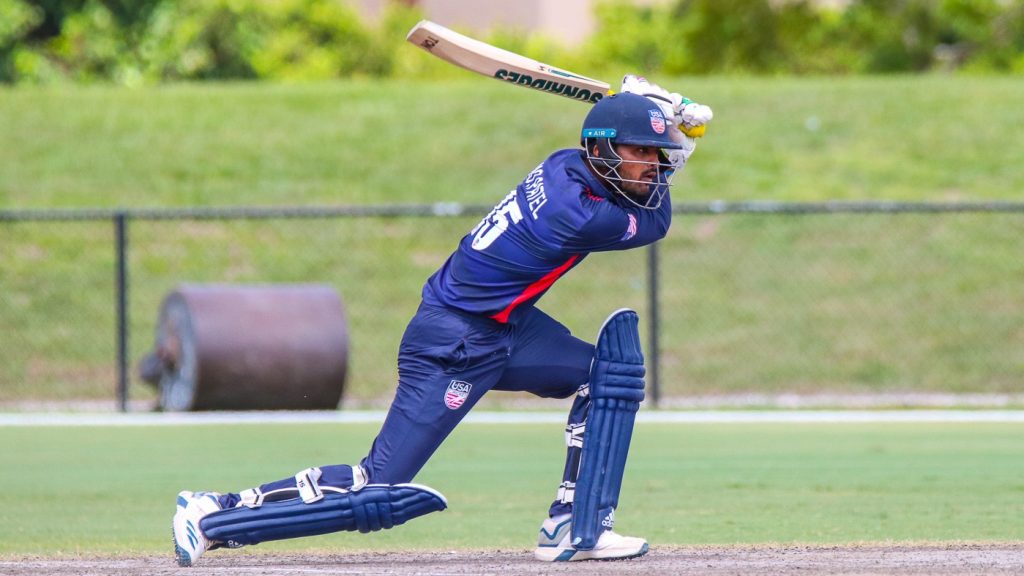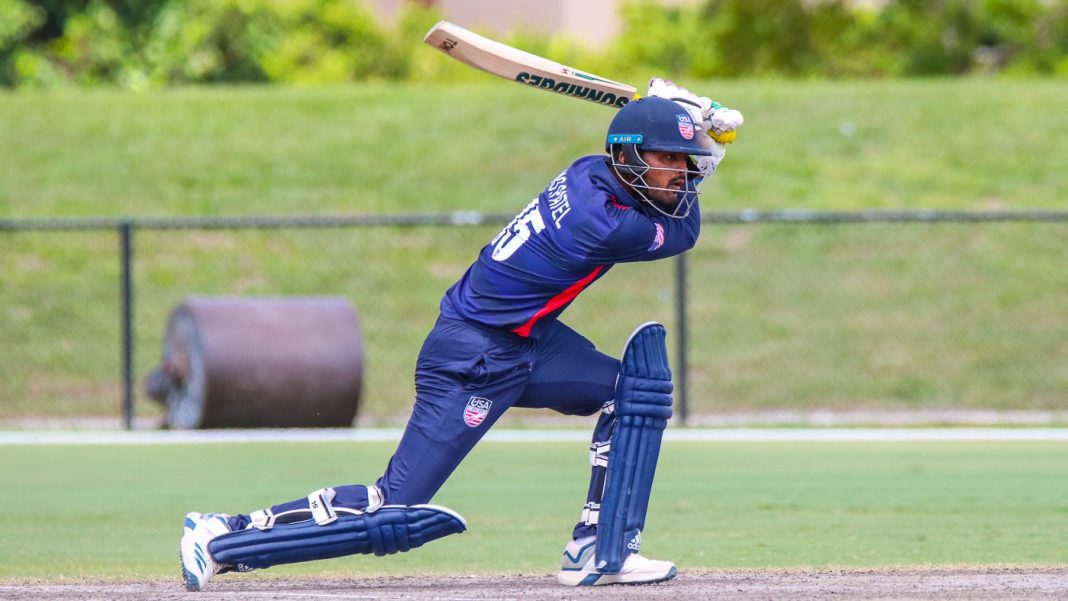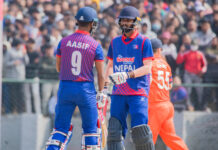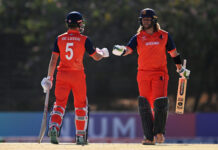The first of nine CWC League 2 rounds has come to a close for Team USA. It’s been a pleasant start overall, with three wins and a loss. There have been plenty of moments to savor as well as the areas that require fine-tuning. The next event for the Americans is in December – an away tri-series against Scotland and UAE, the hosts.
Here’s a report-card reflection on how each player fared in the recent games – batting could’ve been better, but spin bowling emerged as the juggernaut in the first ever home ODI series.
A
Karima Gore (9 wickets @ 13.66, economy rate of 3.61)
To keep it nice and simple, the star of the show. The 21-year-old left-arm spinner has played all his international cricket this year, and he’s wasted little time to show that he’s a player of high caliber. Gore took full advantage of the spin-friendly conditions and impressed with his ability to consistently flight the ball and vary his pace and length. The high point, of course, was the triple-wicket-maiden against Papua New Guinea, which played a pivotal role in helping his side defend a modest total of 177. In addition, he’s shown that he’s very capable to bat down the order – his 31 against PNG in the opening game was key in resurrecting the innings from a middle-order collapse.

A-
Monank Patel (131 runs @ 43.66)
In a series where runs were markedly difficult to score, the young top-order batsman was one of the positives – and also the co-highest run-getter. In three of the four games, each knock was crucial – in both games against Papua New Guinea, he was a vital cog as No. 4, chipping in with a handy 35 in the first game and then anchoring the innings well in the low-scoring rematch. A naturally aggressive batsman, Patel’s shown impressive ability to adjust, as well as curb his attacking instinct when required.

B+
Steven Taylor (93 runs @ 23.25, 6 wickets @ 19.5, economy rate of 4.47)
The most experienced of them all enjoyed a decently productive all-round performance, but he would’ve wanted to contribute to a much greater extent with the bat, his stronger skill. Often deemed a part-timer, his offspin was more than effective – his four-wicket haul in the first match against Namibia helped derail and eventually wrap up their innings for just 121. His best score with the bat, 43 from 58, came in the same game, during the easy chase. Interestingly enough, he’s in third place for USA in the run charts.
B
Saurabh Netravalkar (2 wickets @ 40.5, economy rate of 3.52)
First off, the skipper definitely bowled better than what the stats suggest. The left-arm seamer has been a relatively underrated figure in the side for quite some time, especially given his ability to extract some swing and unleash his variations every now and then. Netravalkar has backed himself to bowl tightly early on, and succeeded to good effect. Plus he’s a viable death-bowling option, too. That skill was on display in the penultimate over in the first game against PNG – 22 needed from the final two overs, and his slower cutters were hard for the batsmen to read.
Aaron Jones (131 runs @ 32.75)
Heading into this series, the young middle-order batsman was touted as the guy in form. His 77 in the very first game was a masterful knock that combined sturdy defence with occasional bouts of aggression. Aside from that, the other games brought about relatively slimmer returns – but he did top-score in the final game with 44 from 76. The stability is present, and the potential immense – but Jones would definitely look to find another gear in his batting, since his strike rate for this series was just below 60.
Timil Patel (4 wickets @ 20, economy rate of 3.2)
There was a time when the vastly experienced 35-year-old played as a batting allrounder, but in recent times, the batting has taken a bit of a back seat while his legspin has continued to prosper. Strangely enough, he didn’t get a bowl in the first game, but his mixtures of sliders, googlies, and legbreaks were the real deal in the next three games. Despite not taking many wickets, Patel was tasked with bowling long mid-innings spells. Patel and Gore were a potent spin duo for opposition batsmen, who usually remained cautious. He was known to extract plenty of turn from the surface, rendering him unplayable at times.
B-
Nisarg Patel (6 wickets @ 10, economy rate of 4.11)
The left-arm spinner was one of plenty of slow-bowling choices in this series. He was picked as an allrounder, but is now primarily making a name for himself as the partnership breaker. Patel didn’t necessarily get long spells, but he has made an impact whenever presented a chance – in both games against PNG, he got the big wicket of captain Assad Vala. In the first match against Namibia, he closed out the innings with the wicket of Zane Green. His bowling exploits have been appreciable thus far, but given the frailty of the USA middle order, he will have to chip in with the bat just as frequently.

C+
Elmore Hutchinson (71 runs @ 35.5, 0 wickets
Long story short – mediocre with the ball, but devastating down the order with the bat. Whenever the innings needed the positive finish, Hutchinson was able to provide the late flourish. His unbeaten 21-ball 42 (1 four, 4 sixes) in the first game dragged USA over the 250 threshold on a tough surface; a 24-ball 28 in the third game prevented the innings from a collapse. However, as a bowler, he was exposed for his lack of pace, especially since bowling is his strong suit. At 37, there is considerably less time to rectify, but his experience can definitely come in handy.
Jessy Singh (4 wickets @ 20.25, economy rate of 5.4)
Chosen to play in the absence of Rusty Theron, the right-arm pacer had a mixed bag of performances. In his first two games – against Namibia and then PNG, he bowled relatively short but decent spells due to the fact that surfaces heavily favored spin. Singh had a proper opportunity in the final game to capitalize on. Early in the Namibia innings, he was off to a fiery start, and even broke a threatening stand between JP Kotze and Gerhard Erasmus. However, death bowling seems to be a concern. His yorker attempts often ended up overpitched or as full-tosses that easily got put away for boundaries. Singh may have bagged a four-wicket haul, but controlling line and length will be an area of major focus. He’s likely done well enough to get another go.
Rusty Theron (1 wicket, economy rate of 7.4)
After seven long years, the 34-year-old South African seamer finally got a chance at a second shot at international cricket – this time for the USA, his new home. He got to play in the very first game against PNG, and then injury sidelined him for the remainder. Theron appears to have lost some pace since he last played top-flight cricket in South Africa, but more importantly, he’s shown to handle pressure well. With 16 runs needed for PNG, he was able to nail his yorker length to great effect. Despite somewhat expensive returns, it’s safe to say he’s exceeded expectations in his first go.
D
Jaskaran Malhotra (52 runs @ 13)
Given the extended opportunities he’s got in the team, it’s been quite a disappointing run this year for the wicketkeeper-batsman. He’s normally known to get off to an encouraging start, which he has, but his inability to convert these starts into bigger scores has made him a liability at the top of the order. In this series, he often connected with a few stylish shots, but the craving for quick runs has often reduced his contributions to brief cameos. Behind the stumps, he’s been mostly tidy but at times he’s had trouble dealing with extra spin off the surface, conceding byes.
Xavier Marshall (41 runs @ 10.25)
Expectations were higher for the seasoned 33-year-old opener, who once played for the West Indies. Sadly, he consumed several dot balls and seldom found his range. His minimal footwork when the ball is swinging and his vulnerability against spin have cost him his wicket. He was backed for four games, but couldn’t take the initiative. With younger openers throwing their hat in the ring, it seems like time has all but ran out.







